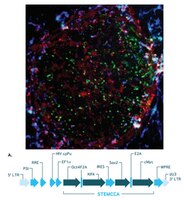SCR511 Sigma-AldrichSTEMCCA Cre-Excisable Constitutive Polycistronic (OKSM) Lentivirus Reprogramming Kit
The STEMCCA Cre-Excisable Constitutive Polycistronic Lentivirus Kit contains high titer polycistronic lentivirus & Polybrene transfection reagent that have been validated for the generation of mouse & human induced pluripotent stem cells.
More>> The STEMCCA Cre-Excisable Constitutive Polycistronic Lentivirus Kit contains high titer polycistronic lentivirus & Polybrene transfection reagent that have been validated for the generation of mouse & human induced pluripotent stem cells. Less<<お勧めの製品
概要
| Replacement Information |
|---|
| References |
|---|
| Product Information | |
|---|---|
| Components |
|
| Quality Level | MQ100 |
| Biological Information | |
|---|---|
| Stem Cell Type |
|
| Physicochemical Information |
|---|
| Dimensions |
|---|
| Materials Information |
|---|
| Toxicological Information |
|---|
| Safety Information according to GHS |
|---|
| Safety Information |
|---|
| Product Usage Statements | |
|---|---|
| Quality Assurance | Tested to confirm the generation of iPS cells from p3 mouse embryonic fibroblasts and p6 human foreskin fibroblasts. Cre-mediated excision of the reprogramming transgenes has only been validated in the mouse system. Other cell types have not been tested and thus similar results can not be guaranteed. |
| Usage Statement |
|
| Packaging Information | |
|---|---|
| Material Size | 1 kit |
| Transport Information |
|---|
| Supplemental Information |
|---|
| Specifications |
|---|
| Global Trade Item Number | |
|---|---|
| カタログ番号 | GTIN |
| SCR511 | 04053252003851 |
Documentation
STEMCCA Cre-Excisable Constitutive Polycistronic (OKSM) Lentivirus Reprogramming Kit (M)SDS
| タイトル |
|---|
参考資料
| 参考資料の概要 | Pub Med ID |
|---|---|
| Excision of viral reprogramming cassettes by Cre protein transduction enables rapid, robust and efficient derivation of transgene-free human induced pluripotent stem cells. Kadari, Asifiqbal, et al. Stem Cell Res Ther, 5: 47 (2014) 2014 概要を表示する | 24713299
 |
カタログ
| タイトル |
|---|
| Simplifying the iPSC Workflow |
| Stem Cell Research |
データシート
| タイトル |
|---|
| Reprogramming Cell Fate and Function Novel Strategies for iPSC Generation, Characterization, and Differentiation |
| STEMCCA Lentivirus Reprogramming Kits |
Posters
| タイトル |
|---|
| Efficient generation of transgene-free human and mouse iPS cells using a cell-permeant Tat-Cre protein |












